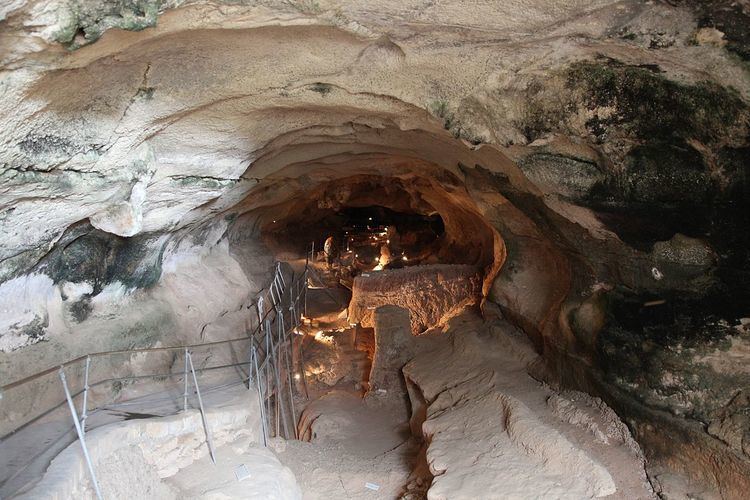Length 144m Phone +356 2165 7419 | Founded c. 5200 BC | |
 | ||
Hours Open today · 9AM–5PMMonday9AM–5PMTuesday9AM–5PMWednesday9AM–5PMThursday9AM–5PMFriday9AM–5PMSaturday9AM–5PMSunday(Saint Joseph's Day)9AM–5PMHours might differ Similar Ħaġar Qim, Mnajdra, Hypogeum of Ħal‑Saflieni, Tarxien Temples, Ġgantija | ||
G ar dalam studji so jali sit preistoriku
Għar Dalam ("Cave of Darkness", [aːr 'dalam]) is a prehistorical cul-de-sac (a cave with only one entrance) located in the outskirts of Birżebbuġa, Malta, containing the bone remains of animals that were stranded and subsequently became extinct in Malta at the end of the Last Glacial Maximum. It has lent its name to the Għar Dalam phase in Maltese prehistory.
Contents
- G ar dalam studji so jali sit preistoriku
- Malta g ar dalam cave of darkness or elephant cave
- Recent history
- Stratigraphy
- References
Dwarf elephant, hippopotamus, deer and bear bone deposits found there are of different ages; the hippopotamuses became extinct about 10,000 years ago, whilst the deer species became extinct much later, about 4000 years ago during the Chalcolithic. It is also here that the earliest evidence of human settlement on Malta, some 7400 years ago, was discovered.
Malta g ar dalam cave of darkness or elephant cave
Recent history
The cave was first scientifically investigated in 1885. It was included on the Antiquities List of 1925, but was not opened to the public until 1933. It was used as an air-raid shelter during World War II. A museum was set up on site by the then-Curator of Natural History, Joseph Baldacchino. In 1980, the most important and irreplaceable relics—such as four tusks of dwarf elephants and the skull of a Neolithic child—were stolen from the museum.
The cave was investigated in 1987 under the direction of Emmanuel Anati, professor of paleontology at the University of Salento. His team of Italian archaeologists from the Centro Camuno di Studi Preistorici discovered Palaeolithic cave art depicting human hands, anthropozoomorphic, and several animal designs from underneath the stalagmatic formations. Some depict elephants which have been extinct in the Maltese region since the Pleistocene. Most of these finds were destroyed due to recent vandalism.
The cave is some 144 metres (472 ft) deep but only the first 50 metres (160 ft) are accessible to visitors. The museum, which still exhibits a remarkable wealth of finds from animal bones to human artifacts, is the entrance to the whole area.
Għar Dalam Cave and Museum is operated by Heritage Malta.
Stratigraphy
The cave consists of six layers.
- Domestic animal layer (c. 74 cm). This layer has mainly cultivated animals in it, such as cows, horses and sheep/goats. Human remains, like pottery, flints, tools and ornaments or amulets are present here.
- Calcareous sheet (c. 0.6 cm).
- Deer Layer (c. 175 cm). The dwarf deer found in this layer are derived from the red deer (Cervus elaphus). Even small numbers of carnivores are known from this layer. Namely brown bear, red fox and wolf. Also big swans, giant turtles and voles are found.
- Pebble layer (c. 35 cm). This layer consists completely of small boulders and pebbles. They are indicators of a river that streamed through the cave. Since the stones are quite large, it was a fast-flowing river.
- Hippopotamus layer (c. 120 cm). This layer consists of mainly Hippopotamus melitensis. Other species found are dwarf elephant and the giant dormouse Leithia cartei.
- Bone-Free clay layer (c. 125 cm). No bones found in this layer, only some impressions of plant material
